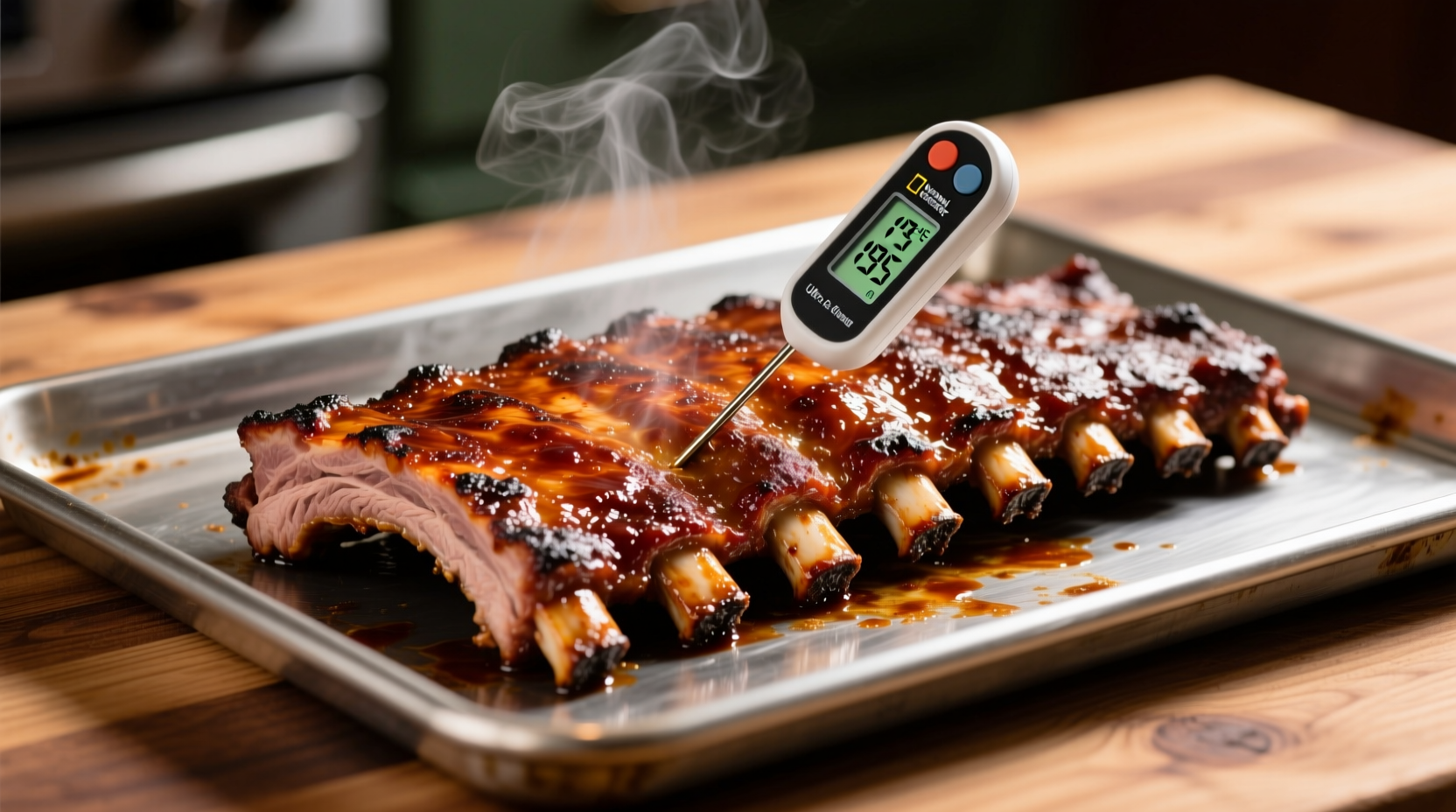Why Temperature Matters for Perfect Oven Ribs
Getting the oven temperature right for ribs isn't just about food safety—it's the key to transforming tough connective tissue into melt-in-your-mouth perfection. Unlike most meats where you cook to a specific internal temperature, ribs require a delicate balance of time and external heat to break down collagen without drying out the meat.
The Science Behind Rib Cooking Temperatures
When cooking ribs, you're not just heating meat—you're triggering a biochemical transformation. Collagen, the tough connective tissue in ribs, begins converting to gelatin at 160°F, but the process accelerates significantly between 195-205°F. This scientific principle, documented by the USDA Food Safety and Inspection Service, explains why ribs need higher internal temperatures than other pork cuts.
| Oven Temperature | Approximate Cooking Time | Best For | Texture Result |
|---|---|---|---|
| 225°F | 4-5 hours | Traditional low-and-slow method | Extremely tender, slightly chewy |
| 250°F | 3.5-4.5 hours | Balance of time and tenderness | Ideal fall-off-the-bone texture |
| 275°F | 3-4 hours | Weeknight cooking | Fall-off-the-bone, slightly less structured |
| 300°F+ | 2-2.5 hours | Emergency situations | Risk of dryness, less tender |
Your Step-by-Step Rib Cooking Journey
Preparation Phase: Setting Up for Success
Before you even preheat your oven, proper preparation determines your rib's fate. Remove the membrane from the bone side—this translucent layer prevents seasoning penetration and causes uneven cooking. Season generously with your rub, then let the ribs rest for at least 30 minutes. This crucial step allows flavors to penetrate and helps form a delicious bark during cooking.
Oven Setup: Creating the Perfect Environment
Position your oven rack in the center and preheat to your chosen temperature (225°F-275°F). Place a drip pan filled with water on the bottom rack to maintain moisture. For authentic barbecue flavor without a smoker, add a few wood chips to the drip pan. Use an oven thermometer to verify accuracy—most ovens have significant temperature variations that can ruin your ribs.

Cooking Phase: The Critical Hours
Place ribs bone-side down on a wire rack set over a baking sheet. Cook undisturbed for the first 2 hours—resist the urge to peek! After 2 hours, check tenderness using the bend test: pick up the rack with tongs; if it bends easily and small cracks form in the surface, you're on track. For saucy ribs, apply barbecue sauce during the last 30-60 minutes of cooking to prevent burning.
Doneness Verification: Beyond Guesswork
Don't rely solely on time—your ribs' internal temperature tells the real story. Insert a meat thermometer between bones into the thickest part. While the USDA recommends 145°F for pork safety, ribs need 195-203°F for optimal tenderness. At this temperature range, collagen fully converts to gelatin, creating that signature pull-back from the bones. As culinary scientist Harold McGee explains in On Food and Cooking, this temperature threshold is non-negotiable for perfect rib texture.
Resting: The Final Transformation
Never skip resting! Wrap ribs in foil and let them rest for 20-30 minutes. This allows residual heat to complete the collagen conversion and redistributes juices throughout the meat. Cutting too soon releases precious moisture, resulting in drier ribs. During this critical phase, the internal temperature typically rises another 5-10 degrees—the "carryover cooking" phenomenon confirmed by America's Test Kitchen research.
Troubleshooting Common Rib Problems
Dry ribs? Your oven temperature was likely too high. Temperatures above 300°F cause fat to render too quickly, leaving ribs dry. Next time, try 250°F with a water pan.
Tough ribs? They haven't reached the magic 195°F internal temperature. Return to oven and check every 20 minutes until tender.
Burning sauce? Apply sauce later in the cooking process or use a water bath technique to moderate oven temperature fluctuations.
Advanced Temperature Techniques
For competition-level ribs at home, try the 3-2-1 method: 3 hours at 225°F unwrapped, 2 hours wrapped in foil with liquid, and 1 hour unwrapped with sauce. This technique, popularized by barbecue champions, creates unparalleled tenderness while maintaining structure. The foil phase (often called the "Texas crutch") dramatically increases internal temperature while preventing moisture loss.
Frequently Asked Questions
Can I cook ribs at 350°F for faster results?
While possible, 350°F is generally too high for ribs. This temperature causes fat to render too quickly, resulting in dry meat. If short on time, 300°F for 2-2.5 hours produces better results, but you'll sacrifice some tenderness compared to lower temperatures.
Why do ribs need higher internal temperatures than other pork?
Ribs contain abundant collagen that requires 195-203°F to fully convert to gelatin. While the USDA minimum safe temperature for pork is 145°F, this only ensures safety, not tenderness. The higher temperature breaks down connective tissues that would otherwise make ribs tough.
Should I adjust cooking temperature for different rib types?
Yes. Baby back ribs (more tender) do well at 275°F for 3-3.5 hours, while tougher spare ribs benefit from 225°F for 4.5-5 hours. St. Louis-style ribs fall in between, perfect at 250°F for 4 hours. The cooking time varies based on the rib's connective tissue content.
How do I prevent ribs from drying out in the oven?
Maintain moisture by using a water pan in the oven, wrapping ribs in foil during part of cooking, and keeping oven temperature below 275°F. Spritzing with apple juice every 60-90 minutes also helps. Most importantly, don't exceed 203°F internal temperature, as higher temps cause excessive moisture loss.











 浙公网安备
33010002000092号
浙公网安备
33010002000092号 浙B2-20120091-4
浙B2-20120091-4